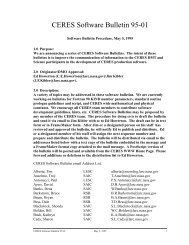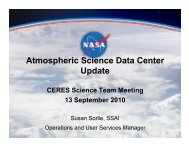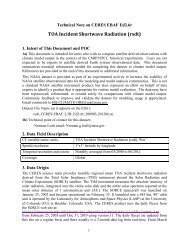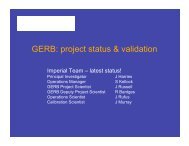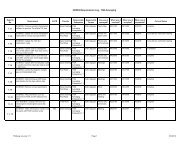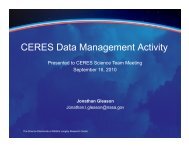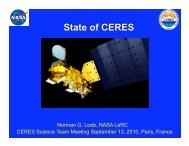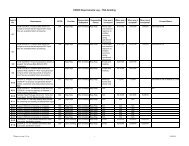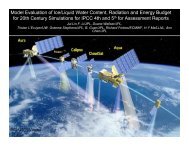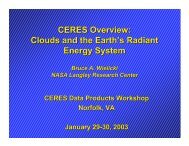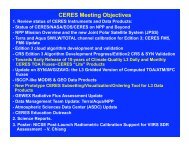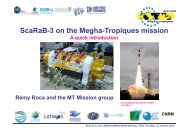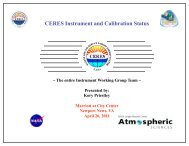Towards Improved CERES Angular Distribution Models
Towards Improved CERES Angular Distribution Models
Towards Improved CERES Angular Distribution Models
Create successful ePaper yourself
Turn your PDF publications into a flip-book with our unique Google optimized e-Paper software.
<strong>Towards</strong> <strong>Improved</strong> <strong>CERES</strong><br />
<strong>Angular</strong> <strong>Distribution</strong> <strong>Models</strong><br />
Wenying Su Lusheng Liang<br />
Joseph Corbett Zachary Eitzen<br />
SSAI, Hampton VA<br />
Thanks to Norman Loeb!
Radiance and flux<br />
• <strong>CERES</strong> measures radiance: I(θ 0 , θ, ϕ)<br />
• Relationship between radiance and flux:<br />
θ 0<br />
θ<br />
ϕ<br />
10/04/11 <strong>CERES</strong> STM <br />
1
The road from radiance to flux:<br />
angular distribution model<br />
• Sort observed radiances into angular bins over different<br />
scene types;<br />
• Integrate radiance over all θ and ϕ to estimate the<br />
anisotropic factor for each scene type;<br />
• Apply anisotropic factor to observed radiance to derive<br />
TOA flux;<br />
10/04/11 <strong>CERES</strong> STM 2
SW ADM for different scene types: Ed2 vs Ed4<br />
Scene Ed2 Ed4 <br />
Clear <br />
Land <br />
Clear <br />
Ocean <br />
Cloud <br />
Ocean <br />
Cloud <br />
Land <br />
Fresh <br />
Snow <br />
Perm. <br />
Snow <br />
Sea‐Ice <br />
1° regional monthly ADM using <br />
Ahmad&Deering 8‐parameter fit; <br />
FuncJon of wind speed; correcJon for <br />
AOD; <br />
ConJnuous 5‐parameter sigmoid <br />
funcJon of ln(fτ) for three phases; <br />
ConJnuous 5‐parameter sigmoid <br />
funcJon of ln(fτ) for three phases; <br />
background albedo from clear land; <br />
Snow fracJon, surface brightness, cloud <br />
fracJon, cloud opJcal depth; <br />
Surface brightness, cloud fracJon, <br />
cloud opJcal depth; <br />
Ice fracJon, surface brightness, cloud <br />
fracJon, cloud opJcal depth; <br />
1° regional monthly ADM using <br />
modified RossLi 3‐parameter fit; <br />
FuncJon of wind speed, AOD and <br />
aerosol types (mariJme and dust); <br />
Update using the Ed2 method; <br />
Update using the Ed2 method; <br />
1° regional monthly ADM using RossLi 3‐<br />
para fit for different NDVI for clear‐sky; <br />
Snow index, cloud fracJon, cloud opJcal <br />
depth; <br />
Sea ice index, cloud fracJon, cloud <br />
opJcal depth; <br />
10/04/11 <strong>CERES</strong> STM 3
LW ADM for different scene types: Ed2 vs Ed4<br />
Scene Ed2 Ed4 <br />
Clear <br />
Ocean/Land <br />
Discrete intervals of precip. water, lapse <br />
rate, skin temp. for six surface types; <br />
Increase skin temp. intervals from 5 <br />
to 10 and add interpolaJon; <br />
Cloudy <br />
Ocean/Land <br />
Fresh Snow <br />
Permanent <br />
Snow <br />
Sea‐Ice <br />
Third‐order polynomial fits between <br />
radiance and ‘pseudoradiance’ for <br />
intervals of precip. water, cloud <br />
fracJon, surface skin temp. and sfc‐cld <br />
temp. difference; <br />
Discrete intervals of cloud fracJon, <br />
surface skin temp., and sfc‐cld temp. <br />
difference; <br />
Discrete intervals of cloud fracJon, <br />
surface skin temp., and sfc‐cld temp. <br />
difference; <br />
Discrete intervals of cloud fracJon, <br />
surface skin temp., and sfc‐cld temp. <br />
difference; <br />
InterpolaJon between radiance and <br />
‘pseudoradiance’ for intervals of <br />
precip. water, cloud fracJon, surface <br />
skin temp. and sfc‐cld temp. <br />
difference; <br />
10/04/11 <strong>CERES</strong> STM 4
Predicted radiance vs. observed radiance<br />
• Predicted radiances can be used to verify the accuracy<br />
of ADM;<br />
10/04/11 <strong>CERES</strong> STM 5
Normalize predicted and observed radiance<br />
Observed radiance:<br />
1°<br />
Predicted radiance:<br />
1°<br />
• RMS error between normalized predicted radiance and<br />
normalized observed radiance is closely related to the ADM error<br />
• RMS error of 10% (20%) corresponds to flux RMS error of about<br />
2~12 (4~15) Wm -2 over different scene types based upon<br />
theoretical simulations<br />
10/04/11 <strong>CERES</strong> STM 6
<strong>Angular</strong> distribution model over clear land/desert<br />
Scene Ed2 Ed4 <br />
Clear <br />
Land <br />
Clear <br />
Ocean <br />
Cloud <br />
Ocean <br />
Cloud <br />
Land <br />
Fresh <br />
Snow <br />
Perm. <br />
Snow <br />
Sea‐Ice <br />
1° regional monthly ADM using <br />
Ahmad&Deering 8‐parameter fit; <br />
FuncJon of wind speed; correcJon for <br />
AOD; <br />
ConJnuous 5‐parameter sigmoid <br />
funcJon of ln(fτ) for three phases; <br />
ConJnuous 5‐parameter sigmoid <br />
funcJon of ln(fτ) for three phases; <br />
background albedo from clear land; <br />
Snow fracJon, surface brightness, cloud <br />
fracJon, cloud opJcal depth; <br />
Surface brightness, cloud fracJon, <br />
cloud opJcal depth; <br />
Ice fracJon, surface brightness, cloud <br />
fracJon, cloud opJcal depth; <br />
1° regional monthly ADM using <br />
modified RossLi 3‐parameter fit; <br />
FuncJon of wind speed, AOD and <br />
aerosol types (mariJme and dust); <br />
Update using the Ed2 method; <br />
Update using the Ed2 method; <br />
1° regional monthly ADM using RossLi 3‐<br />
para fit for different NDVI; <br />
Snow index, cloud fracJon, cloud opJcal <br />
depth; <br />
Sea ice index, cloud fracJon, cloud <br />
opJcal depth; <br />
10/04/11 <strong>CERES</strong> STM 7
A simpler BRDF model for clear-sky land: Modified RossLi<br />
• B1 estimates the directional reflectance of a flat surface<br />
with randomly distributed and oriented protrusions;<br />
• B2 approximates the radiative transfer within a<br />
vegetation canopy, accounts for the hot spot effect;<br />
from Maignan et al., 2004<br />
Kernel B1<br />
Kernel B2<br />
10/04/11 <strong>CERES</strong> STM 8
Modified RossLi BRDF model reduces the RMS error<br />
RMS error (%) using prototype Ed4 ADM for 200305 FM2<br />
over clear-sky land/desert: Mean RMS error = 5.5%<br />
%<br />
10/04/11 <strong>CERES</strong> STM 9
Modified RossLi BRDF model reduces the RMS error<br />
RMS error (%) using Ed2 ADM for 200305 FM2<br />
over clear-sky land/desert: Mean RMS error = 6.1%<br />
%<br />
10/04/11 <strong>CERES</strong> STM 10
SW angular distribution model over clear ocean<br />
Scene Ed2 Ed4 <br />
Clear <br />
Land <br />
Clear <br />
Ocean <br />
Cloud <br />
Ocean <br />
Cloud <br />
Land <br />
Fresh <br />
Snow <br />
Perm. <br />
Snow <br />
Sea‐Ice <br />
1° regional monthly ADM using <br />
Ahmad&Deering 8‐parameter fit; <br />
FuncJon of wind speed; correcJon for <br />
AOD; <br />
ConJnuous 5‐parameter sigmoid <br />
funcJon of ln(fτ) for three phases; <br />
ConJnuous 5‐parameter sigmoid <br />
funcJon of ln(fτ) for three phases; <br />
background albedo from clear land; <br />
Snow fracJon, surface brightness, cloud <br />
fracJon, cloud opJcal depth; <br />
Surface brightness, cloud fracJon, <br />
cloud opJcal depth; <br />
Ice fracJon, surface brightness, cloud <br />
fracJon, cloud opJcal depth; <br />
1° regional monthly ADM using <br />
modified RossLi 3‐parameter fit; <br />
FuncJon of wind speed, AOD and <br />
aerosol types (mariJme and dust); <br />
Update using the Ed2 method; <br />
Update using the Ed2 method; <br />
1° regional monthly ADM using RossLi 3‐<br />
para fit for different NDVI for clear‐sky; <br />
Snow index, cloud fracJon, cloud opJcal <br />
depth; <br />
Sea ice index, cloud fracJon, cloud <br />
opJcal depth; <br />
10/04/11 <strong>CERES</strong> STM 11
Clear-sky angular distribution model over ocean<br />
• Clear-sky ADM over ocean R(w, θ 0 , θ, ϕ);<br />
• Aerosol optical depth was not directly considered, ADM<br />
dependence on aerosol optical depth is implicitly accounted<br />
for by theoretical adjustment.<br />
RMS error (%) using Ed2 ADM for all RAPS data<br />
over clear-sky ocean: mean RMS error = 10.7%<br />
%<br />
10/04/11 <strong>CERES</strong> STM 12
New clear-sky ADM accounts for aerosol loading and type<br />
• Develop a two-channel (0.64 and 0.86 µm) AOD retrieval<br />
using maritime and dust aerosols;<br />
• Stratify AOD into bins (2 for maritime and 3 for dust);<br />
• Build ADM for each AOD bin and type separately (5 ADMs).<br />
RMS error (%) using prototype Ed4 ADM for all RAPS data<br />
over clear-sky ocean: mean RMS error = 8.4%<br />
%<br />
10/04/11 <strong>CERES</strong> STM 13
New clear-sky ocean ADM increases the<br />
instantaneous TOA flux by 0.5 Wm -2<br />
Flux differences (new-old) using all RAP data<br />
(03/2000 to 05/2005)<br />
(Wm -2 )<br />
10/04/11 <br />
<strong>CERES</strong> STM 14
<strong>Angular</strong> distribution model over cloudy ocean<br />
Scene Ed2 Ed4 <br />
Clear <br />
Land <br />
Clear <br />
Ocean <br />
Cloud <br />
Ocean <br />
Cloud <br />
Land <br />
Fresh <br />
Snow <br />
Perm. <br />
Snow <br />
Sea‐Ice <br />
1° regional monthly ADM using <br />
Ahmad&Deering 8‐parameter fit; <br />
FuncJon of wind speed; correcJon for <br />
AOD; <br />
ConJnuous 5‐parameter sigmoid <br />
funcJon of ln(fτ) for three phases; <br />
ConJnuous 5‐parameter sigmoid <br />
funcJon of ln(fτ) for three phases; <br />
background albedo from clear land; <br />
Snow fracJon, surface brightness, cloud <br />
fracJon, cloud opJcal depth; <br />
Surface brightness, cloud fracJon, <br />
cloud opJcal depth; <br />
Ice fracJon, surface brightness, cloud <br />
fracJon, cloud opJcal depth; <br />
1° regional monthly ADM using <br />
modified RossLi 3‐parameter fit; <br />
FuncJon of wind speed, AOD and <br />
aerosol types (mariJme and dust); <br />
Update using the Ed2 method; <br />
Update using the Ed2 method; <br />
1° regional monthly ADM using RossLi 3‐<br />
para fit for different NDVI; <br />
Snow index, cloud fracJon, cloud opJcal <br />
depth; <br />
Sea ice index, cloud fracJon, cloud <br />
opJcal depth; <br />
10/04/11 <strong>CERES</strong> STM 15
<strong>Angular</strong> distribution model over cloudy ocean<br />
• For glint angle > 20°, or glint angle < 20° and ln(fτ) > 6:<br />
– Average instantaneous radiances into 750 intervals of ln(fτ);<br />
– Apply a five-parameter sigmoidal fit to mean radiance and ln(fτ);<br />
• For glint angle < 20° and ln(fτ) < 6:<br />
– Calculate mean radiance for 6 wind speed bins and 4 ln(fτ) bins;<br />
– Use mean radiance to build ADM<br />
10/04/11 <strong>CERES</strong> STM 16
A case of sigmoidal fit over ocean<br />
10/04/11 <strong>CERES</strong> STM 17
Do we need to consider other variables to define the ADM?<br />
• Current ADM considers cloud optical depth, cloud<br />
fraction, and cloud phase;<br />
• Are there any other variables that we need to consider?<br />
– Cloud top pressure<br />
– Cloud droplet size<br />
– Standard deviation of cloud optical depth<br />
– Precipitable water<br />
10/04/11 <strong>CERES</strong> STM 18
Sigmoidal fit is not sensitive to other variables<br />
Stratify by cloud top pressure<br />
Stratify by precip. water<br />
median<br />
median<br />
Stratify by Std of COD<br />
median<br />
Stratify by droplet effective radius<br />
median<br />
10/04/11 <strong>CERES</strong> STM <br />
19
RMS error between normalized predicted<br />
and measured radiance<br />
%<br />
10/04/11 <strong>CERES</strong> STM 20
<strong>Angular</strong> distribution model over cloudy land/desert<br />
Scene Ed2 Ed4 <br />
Clear <br />
Land <br />
Clear <br />
Ocean <br />
Cloud <br />
Ocean <br />
Cloud <br />
Land <br />
Fresh <br />
Snow <br />
Perm. <br />
Snow <br />
Sea‐Ice <br />
1° regional monthly ADM using <br />
Ahmad&Deering 8‐parameter fit; <br />
FuncJon of wind speed; correcJon for <br />
AOD; <br />
ConJnuous 5‐parameter sigmoid <br />
funcJon of ln(fτ) for three phases; <br />
ConJnuous 5‐parameter sigmoid <br />
funcJon of ln(fτ) for three phases; <br />
background albedo from clear land; <br />
Snow fracJon, surface brightness, cloud <br />
fracJon, cloud opJcal depth; <br />
Surface brightness, cloud fracJon, <br />
cloud opJcal depth; <br />
Ice fracJon, surface brightness, cloud <br />
fracJon, cloud opJcal depth; <br />
1° regional monthly ADM using <br />
modified RossLi 3‐parameter fit; <br />
FuncJon of wind speed, AOD and <br />
aerosol types (mariJme and dust); <br />
Update using the Ed2 method; <br />
Update using the Ed2 method; <br />
1° regional monthly ADM using RossLi 3‐<br />
para fit for different NDVI; <br />
Snow index, cloud fracJon, cloud opJcal <br />
depth; <br />
Sea ice index, cloud fracJon, cloud <br />
opJcal depth; <br />
10/04/11 <strong>CERES</strong> STM 21
<strong>Angular</strong> distribution model over cloudy land/desert<br />
• Derive cloudy area contribution from observed radiance:<br />
• Average instantaneous fI cld into 375 intervals of ln(fτ)<br />
for each angular bin (5°) for three cloud phases;<br />
• Apply a five-parameter sigmoidal fit to mean fI cld and<br />
ln(fτ);<br />
10/04/11 <strong>CERES</strong> STM 22
A case of sigmoidal fit over land<br />
10/04/11 <strong>CERES</strong> STM 23
RMS error between normalized predicted<br />
and measured radiance<br />
%<br />
10/04/11 <strong>CERES</strong> STM 24
SW angular distribution model over permanent snow<br />
Scene Ed2 Ed4 <br />
Clear <br />
Land <br />
Clear <br />
Ocean <br />
Cloud <br />
Ocean <br />
Cloud <br />
Land <br />
Fresh <br />
Snow <br />
Perm. <br />
Snow <br />
Sea‐Ice <br />
1° regional monthly ADM using <br />
Ahmad&Deering 8‐parameter fit; <br />
FuncJon of wind speed; correcJon for <br />
AOD; <br />
ConJnuous 5‐parameter sigmoid <br />
funcJon of ln(fτ) for three phases; <br />
ConJnuous 5‐parameter sigmoid <br />
funcJon of ln(fτ) for three phases; <br />
background albedo from clear land; <br />
Snow fracJon, surface brightness, cloud <br />
fracJon, cloud opJcal depth; <br />
Surface brightness, cloud fracJon, <br />
cloud opJcal depth; <br />
Ice fracJon, surface brightness, cloud <br />
fracJon, cloud opJcal depth; <br />
1° regional monthly ADM using <br />
modified RossLi 3‐parameter fit; <br />
FuncJon of wind speed, AOD and <br />
aerosol types (mariJme and dust); <br />
Update using the Ed2 method; <br />
Update using the Ed2 method; <br />
1° regional monthly ADM using RossLi 3‐<br />
para fit for different NDVI for clear‐sky; <br />
Snow index, cloud fracJon, cloud opJcal <br />
depth; <br />
Sea ice index, cloud fracJon, cloud <br />
opJcal depth; <br />
10/04/11 <strong>CERES</strong> STM 25
Why reflectance and albedo are sensitive to solar azimuth?<br />
• Use Dec. clear-sky data over south pole (88~89S, -93~-101W);<br />
• <strong>Angular</strong> bins: SZA [65~70]; VZA [55~70]; RAZ [60~70];<br />
Albedo Reflectance<br />
0.72<br />
0.70<br />
0.68<br />
0.66<br />
0.64<br />
0.62<br />
0.60<br />
0.70<br />
0.68<br />
0.66<br />
0.64<br />
0.62<br />
0.60<br />
0 50 100 150 200 250 300 350<br />
Solar Azimuth Angle (°)<br />
10/04/11 <strong>CERES</strong> STM 26
Permanent snow surface is not flat: sastrugi<br />
• Sastrugi: An irregularity formed by the wind on a snow<br />
plain. “Snow wave” is not completely descriptive, as the<br />
sastrugi has often a fantastic shape unlike the ordinary<br />
conception of a wave (from Scott’s Last Expedition);<br />
• Sastrugi generally aligned parallel to prevailing wind<br />
direction, but sometimes two or three sets of sastrugi<br />
crossing each other.<br />
Image from homelessHeidi<br />
Bill McAfee<br />
10/04/11 <strong>CERES</strong> STM 27
Regional clear-sky flux bias and the orientation of sastrugi<br />
• Flux bias:<br />
• Difference between most frequent wind direction and solar<br />
azimuth angle<br />
• Positive flux bias when wind direction is parallel to solar azimuth<br />
and negative flux bias when wind direction is perpendicular to<br />
solar azimuth<br />
Flux bias:Wm -2<br />
6<br />
Angle difference (degree)<br />
80°<br />
3<br />
0<br />
60<br />
40<br />
-3<br />
20<br />
-6<br />
10/04/11 <strong>CERES</strong> STM 28 <br />
0
LW angular distribution model over clear ocean/land<br />
Scene Ed2 Ed4 <br />
Clear <br />
Ocean/Land <br />
Cloudy <br />
Ocean/Land <br />
Fresh Snow <br />
Permanent <br />
Snow <br />
Sea‐Ice <br />
Discrete intervals of precip. Water (4), <br />
lapse rate (4), skin temp. (5) for six <br />
surface types; <br />
Third‐order polynomial fits between <br />
radiance and ‘pseudoradiance’ for <br />
intervals of precip. water, cloud <br />
fracJon, surface skin temp. and sfc‐cld <br />
temp. difference; <br />
Discrete intervals of cloud fracJon, <br />
surface skin temp., and sfc‐cld temp. <br />
difference; <br />
Discrete intervals of cloud fracJon, <br />
surface skin temp., and sfc‐cld temp. <br />
difference; <br />
Discrete intervals of cloud fracJon, <br />
surface skin temp., and sfc‐cld temp. <br />
difference; <br />
Increase skin temp. intervals from 5 <br />
to 10 and add interpolaJon; <br />
InterpolaJon between radiance and <br />
‘pseudoradiance’ for intervals of <br />
precip. water, cloud fracJon, surface <br />
skin temp. and sfc‐cld temp. <br />
difference; <br />
10/04/11 <strong>CERES</strong> STM 29
RMS error between normalized predicted<br />
and measured radiance: July 2000 daytime (Ed2)<br />
High errors<br />
over oceans<br />
near Ts=290K<br />
boundary<br />
%<br />
10/04/11 <strong>CERES</strong> STM 30
Increase surface temperature bins + interpolation<br />
reduces the RMS error: July 2000 daytime<br />
%<br />
10/04/11 <strong>CERES</strong> STM 31
More talks on ADM<br />
Co-I talk by Joe Corbett on Thursday<br />
“The Effect of Sastrugi on TOA Albedos from <strong>CERES</strong>”<br />
Working group talk by Zach Eitzen<br />
“Progress in clear-sky Longwave ADMs”<br />
Working group talk by Lusheng Liang<br />
“Impact of Aerosol Type on <strong>CERES</strong> Clear-sky Shortwave<br />
ADM over Ocean”<br />
10/04/11 <strong>CERES</strong> STM 32
Schedule<br />
• Edition 4 SSF?<br />
• Deliver Edition 4 ADM a year after Edition 4 SSF in<br />
production (possible but optimistic goal) !<br />
10/04/11 <strong>CERES</strong> STM 33
Summary<br />
• Thorough evaluation of SW cloudy-sky ADM indicates that<br />
the five-parameter sigmoidal fit is sufficient;<br />
• Aerosol optical depth/type classified clear ocean ADMs<br />
reduce the RMS error between predicted and observed<br />
radiances from 10.7% to 8.4% ;<br />
• Uncertainty in TOA SW fluxes from sastrugi over<br />
Antarctic:<br />
– Monthly-mean: clear-sky < 5 Wm -2 ; all-sky < 2 Wm -2 ;<br />
– Annual-mean all-sky ~0.0 Wm -2 ;<br />
• For LW clear-sky over ocean/land, increasing surface<br />
temperature bins and adding interpolation reduce the RMS<br />
error between normalized predicted and observed<br />
radiances from 1.8% to 1.4%.<br />
10/04/11 <strong>CERES</strong> STM 34



